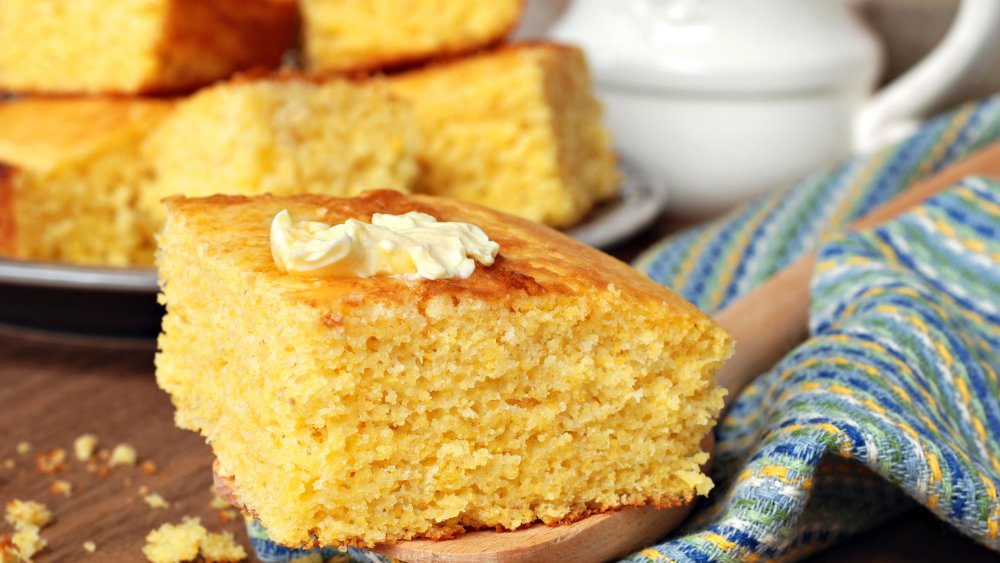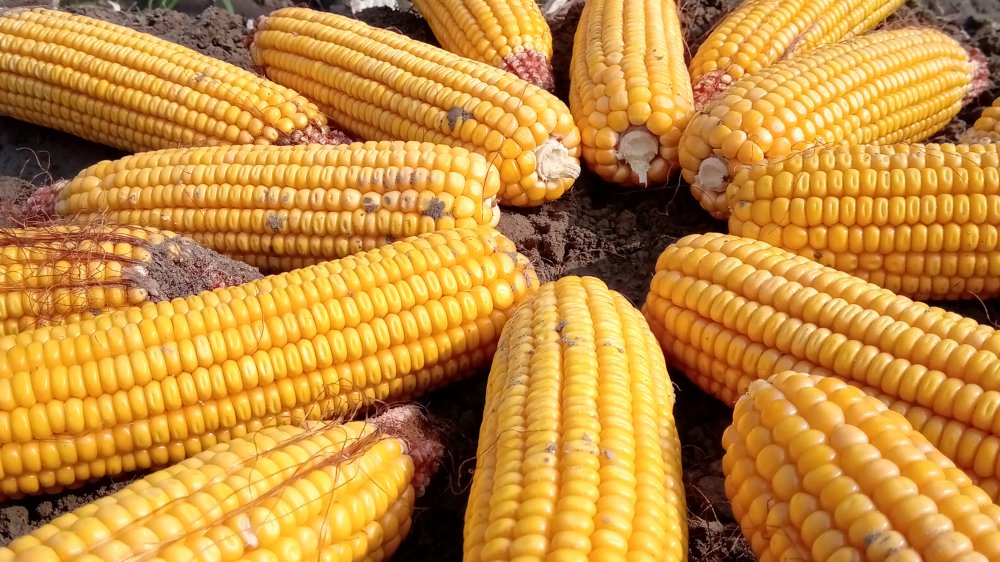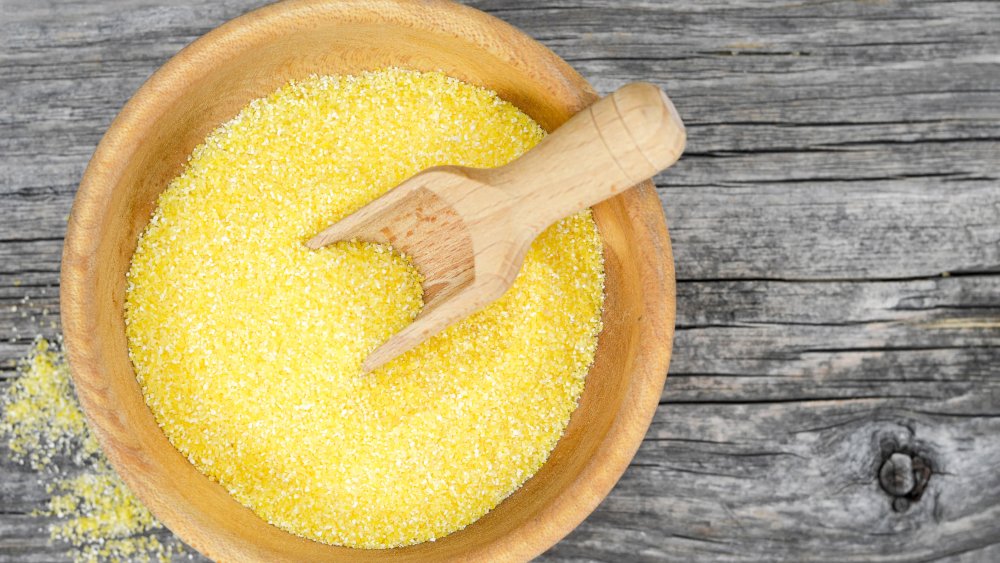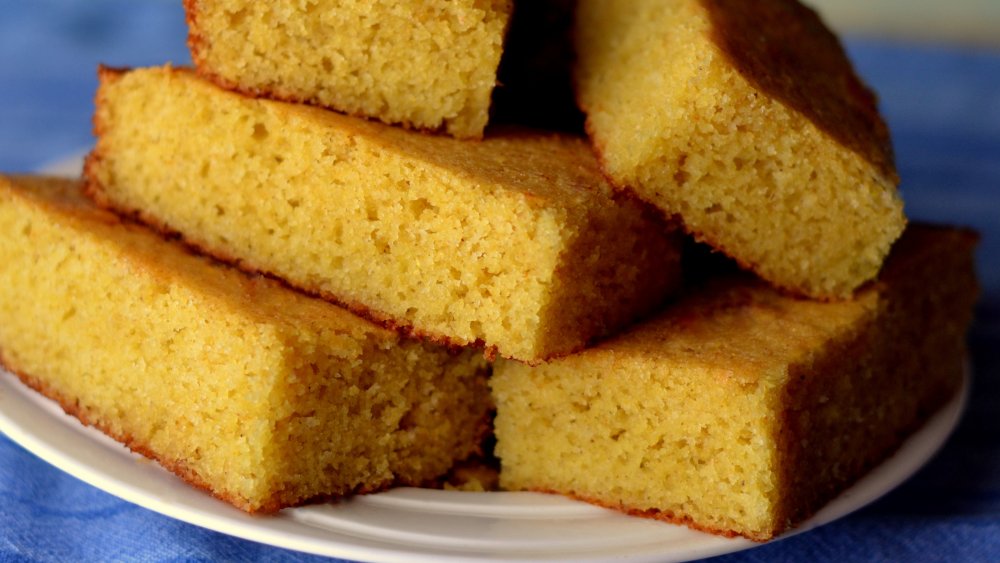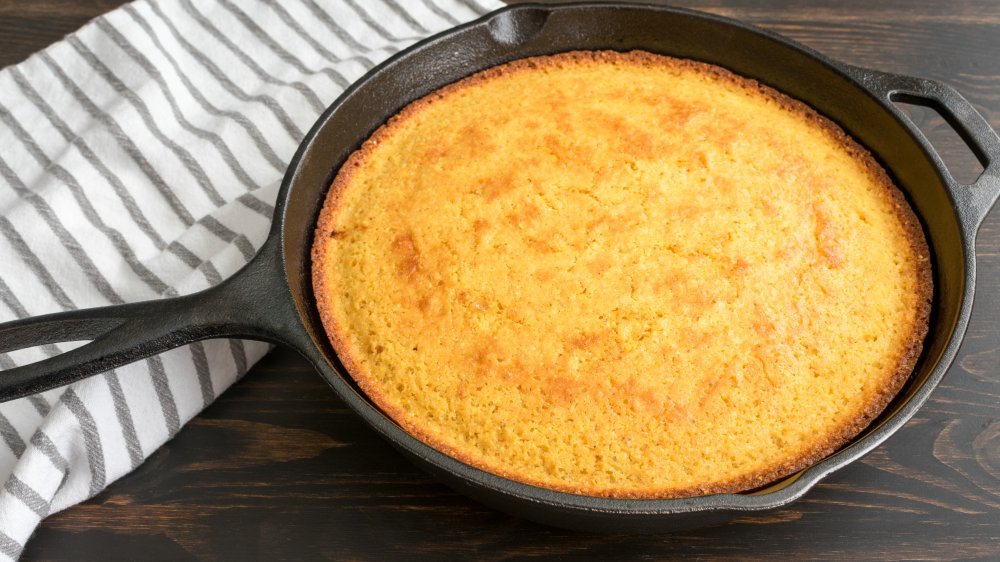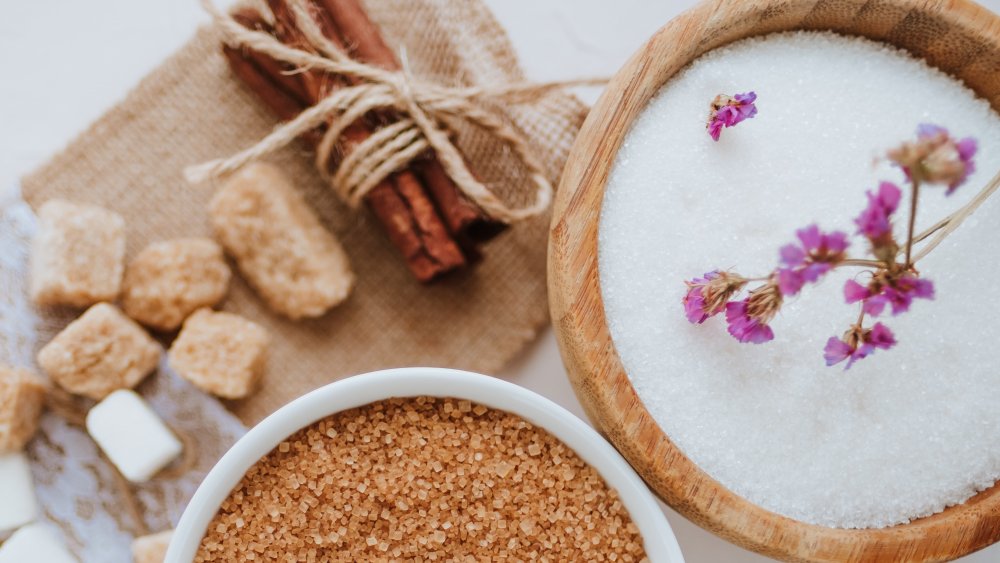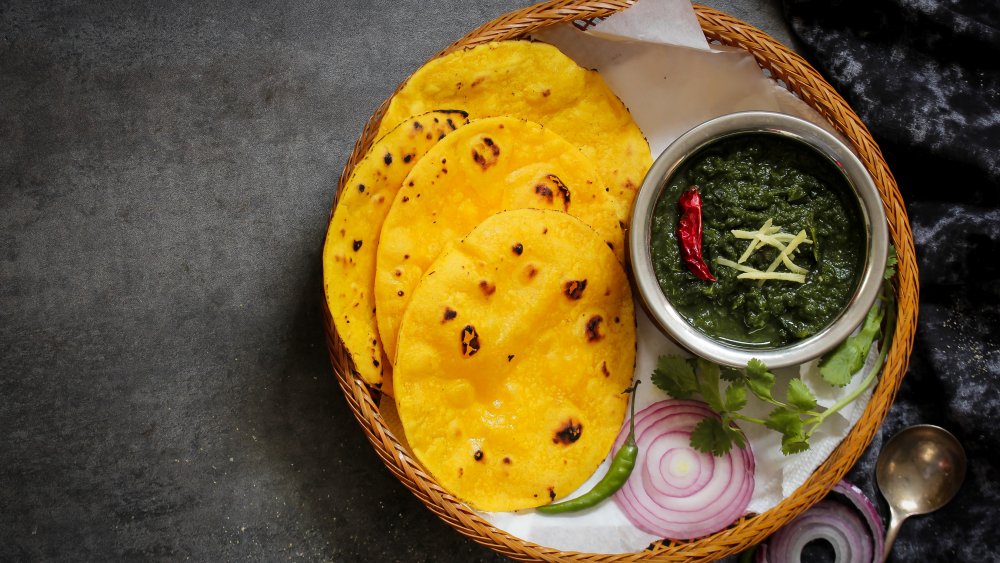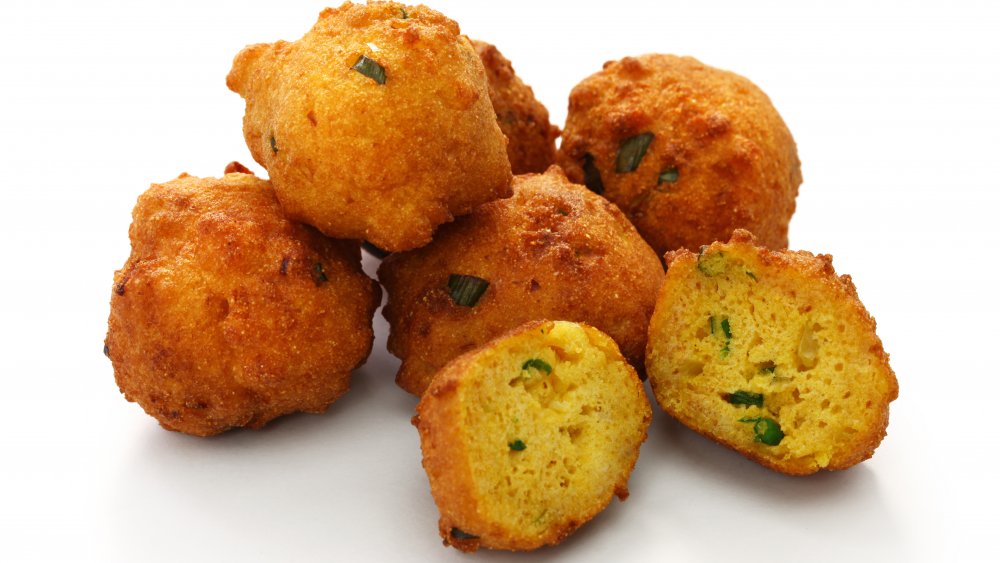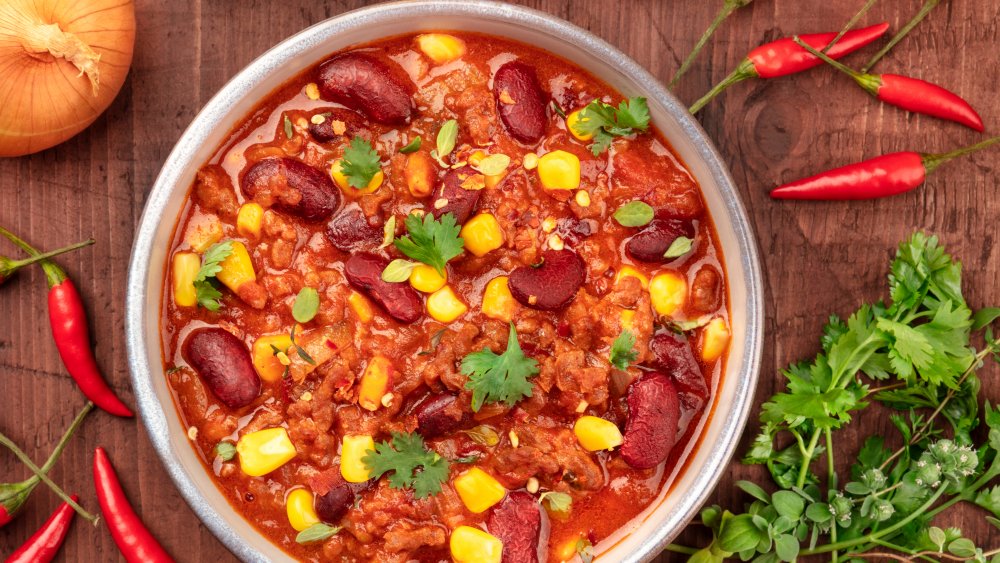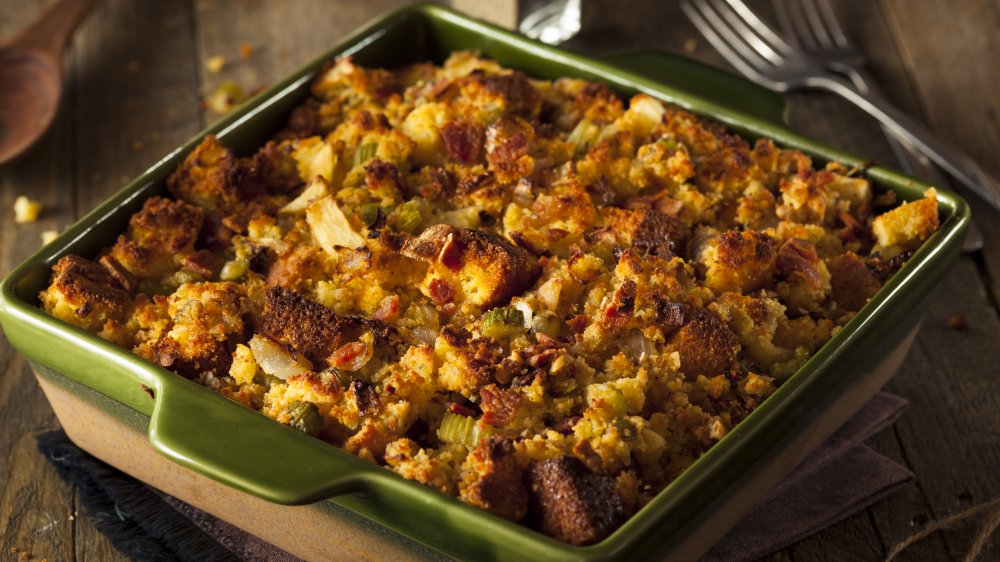Mistakes You're Making With Your Cornbread
If your idea of cornbread heaven is a store-bought cornbread or quickie mix, you may be missing out on one of life's simple pleasures. No two ways about it, neither one stacks up to the taste of homemade cornbread, straight from your oven.
And speaking of simple, whipping up a pan of cornbread doesn't require special skills or baking chops — or even fancy equipment. The thing is, even beginners can experience deep cornbread satisfaction. All it takes are a few stellar ingredients and perhaps, some imagination (that is, if you're planning on experimenting or even going rogue ...) and voila, golden brown cornbread is yours to devour.
Still, to truly appreciate cornbread and its infinite possibilities, it's best to avoid some pitfalls that can make a profound difference in your cornbread's taste and texture, and to school yourself on cornbread's rich history and ingredients, because, well, it makes you a more knowledgeable cook. Even if you've made a pan or two in your cooking life, here are the mistakes you're probably making with your cornbread.
Using the wrong color of cornmeal for your cornbread
Cornmeal plays a central role in your cornbread. How could it be otherwise? While white and yellow cornmeal are the most common types, cornmeal can also be blue or even red. But let's stick to the basics for now, and to the key question in the cornbread equation: Should you use white or yellow cornmeal in your cornbread? Martha White says both types are made from dried kernels corn, using white and yellow corn kernels respectively, and can be used interchangeably in cornbread recipes.
That may be true in some circles, but if you're aiming for Southern cornbread, the granddaddy of cornbread, it's a big mistake to use yellow cornmeal. For cornbread that's true to its down-home roots, only white cornmeal will do. In a column for Southern Kitchen, cookbook author Anne Byrn lays down the law about making Southern cornbread the old-fashioned way, advising readers to use only plain white cornmeal or self-rising white cornmeal when tackling cornbread. In her book, The Essential Good Food Guide, author Margaret M. Wittenberg concurs, noting that white cornmeal, with its subtle, less-pronounced corn flavor, is a crucial ingredient in authentic Southern-style cornbread.
But what if you want a sweeter, cake-like cornbread? In that instance, it's a baking blunder to use white cornmeal. Instead, opt for yellow, rich in beta carotene, with more of a corn-flavor punch.
Using the wrong cornmeal grind for your cornbread
The difference in cornmeal grinds may not seem like a very big deal, but it impacts the flavor of your cornbread. According to TasteAtlas, coarsely-, medium-, and fine-ground cornmeal each differ in taste, and the finest grind of cornmeal is the least sweet. Still, it advises, it would be a misstep to use anything but stone-ground cornmeal, because it lends the most "corn" flavor.
Stone-ground cornmeal, sometimes labeled "whole grain" on the package, is coarser than commercial cornmeal, due to the way it's milled. The germ and bran remain intact in the cornmeal so it doesn't have as long a shelf life as standard cornmeal, which is usually degerminated. In speaking to agricultural experts, Cook's Illustrated found that degermination prior to grinding corn kernels figures into the moistness of your cornbread, noting that the germ that's removed has vitamins, enzymes, and corn oil. While you can certainly find over-the-counter stone-ground brands at the grocery store, it's worth experimenting with artisan stone-ground cornmeal from specialty sources like Anson Mills, known for its organic heirloom corn, rice, and grains, or Marsh Hen Mill, which field dries its corn, then hand mills the cornmeal in antique gristmills.
Bon Appetit reminds us that cornbread should be a textural enterprise, and coarse-grind cornmeal from these fancy brands delivers livelier flavor and more varied grains, so the texture is apparent in every tasty bite.
Making your cornbread too dry and crumbly
Perhaps some people prefer their cornbread dry and crumbly, but most cooks don't aim for a mouthful of corn dust. You can avoid a lapse into Sahara territory and turn out a moist and memorable cornbread by adding, trading, or subtracting a few ingredients.
Our Everyday Life suggests adding extra fat to your batter to make your cornbread less crumbly. Any number of pantry staples will do the trick, from more oil or egg yolks to melted butter or shortening, which softens the cornbread's crumb and makes it less crumbly. Eggs are especially effective, because they combine protein, fat, and moisture, all in one little shell. Another moisture-enhancing strategy is swapping cane sugar for sweeteners like brown sugar, honey, or corn syrup.
On the other end of the ingredient spectrum, flour, or lack thereof, can also contribute to cornbread's texture and density. Delishably reminds us that cornbread should be a bit crumbly (it is cornbread, after all) but it shouldn't fall apart before it reaches your mouth. That's where flour comes in. Adding more wheat flour makes your cornbread less crumbly. While traditional Southern recipes tend to go heavy on the cornmeal, it seems that when you're using too much cornmeal, there isn't enough gluten to hold the cornbread together. So why go all-in for all cornmeal? Instead, add more flour and less cornmeal, and your cornbread will turn out lighter and less dense. Not dry and crumbly.
Skipping the soaking step when making cornbread
While it may take a little more time, and it's certainly an optional step, you won't regret soaking your cornmeal before your whole cornbread comes together. Mountain Feed and Seed Supply's blog lobbies for starting with coarsely ground cornmeal, and soaking it in buttermilk for a few hours. If you happen to be way ahead of schedule, or a whiz at planning ahead, you can even allow the cornmeal and buttermilk mixture to soak overnight. Either way, they say soaking makes the big cornmeal grains more tender, hence making your cornbread — you guessed it — more moist and tender. And who doesn't want that? It seems just plain wrong to opt out.
And if you want to take another soaking path altogether, Milwaukee Magazine notes that soaking both the cornmeal and the wheat flour together in yogurt for 8 hours at room temperature can yield delicious results in the form of a firm and tender cornbread with a really interesting flavor, thanks to the combination of grains. This might very well be what some people call food for thought.
If you're hard-pressed for time or making your cornbread on the fly, and soaking isn't an option, all is not lost. The San Diego Union-Tribune says that giving your batter even 10 minutes of sitting time before the pan goes in the oven will help hydrate your cornbread.
Baking cornbread in anything but a hot cast iron skillet or corn stick pan
Every cook worth their salt knows that preheating the oven is essential for even results, but in the world of cornbread, preheating the pan is also a great idea. And that pan shouldn't be any old brownie or cake pan. Cornbread purists are intractable on this point: A cast-iron skillet (or a cute cast-iron corn stick pan) is the best option if you want results worth bragging about. As The New York Times says, the heavy cast-iron pan retains the heat, lending the cornbread the darkest color, which translates to cornbread with the most flavor. Why bother with anything else?
The Kitchn informs us that you can preheat your pan at the same time that you preheat your oven. And if you're planning on leveling up your cornbread with, say, bacon or sautéed onions or peppers, you can preheat the pan on the stove.
Sharing his cornbread recipe with The Splendid Table, chef Sean Brock, founder of the Charleston, South Carolina restaurant Husk and its Southeastern offshoots, and star of the sixth season of the Netflix series, Chef's Table, also touts the merits of a cast-iron skillet. His method entails preheating his skillet in the oven, then popping it on top of the stove, pouring in the fat (in his case, melted lard) followed by the cornbread batter. Once it sizzles, back in the oven it goes. The end result: a rich brown, caramelized crust.
Believing that sweet cornbread is the only option
Cornbread can get very personal, and make no mistake, controversial. There are staunch believers in savory cornbread, made with buttermilk and no sugar, which is traditionally Southern. There are also those who believe that corn's naturally sweet flavor only gets better when you add in plenty of sugar — that's the Northern variation. There doesn't seem to be a middle ground. While sweet or savory cornbread may be a matter of taste as well as heritage, there's no real way to judge unless you try both.
Garden and Gun is clear on its insistence that Southern cornbread, a fundamental part of Southern cuisine, shouldn't be messed with, noting that there's plenty of sugar in the grain itself — after all, it's used to make liquor. Sugar, it maintains, blots out the wonderful tangy bitterness that the Choctaw, Creek, Chickasaw, and Cherokee Indians achieved with their cornbread, and passed on to the newly landed 17th-century English colonists. Serious Eats takes the same stand, believing that sugar and wheat flour have no place in cornbread, labeling sweet, flour-y variations more like dessert than genuine cornbread.
On the flip side, The San Diego Union-Tribune skips Southern tradition and makes room at the table for a light and fluffy cornbread that's somewhat cake-like and sweet, but not overpoweringly so. A cornbread that's best eaten with a bowl of spicy chili. Sweet or savory, cornbread is also the perfect complement to numerous dishes, including barbecue, pulled pork, and hearty soups.
Overlooking other regional interpretations of cornbread
While perhaps no other part of the world has had as much of an influence on shaping our idea of cornbread perfection as the South, other interpretations of this paragon have earned their due. In fact, it's a mistake not to try some of cornbread's many interpretations.
First, introduce yourself to a regional American favorite: Hello, Tex-Mex cornbread! Living Magazine says that this spicy iteration was born once cornbread reached the West. At that point, each region took liberties with the staple. One version, according to Texas Monthly, is enlivened with green chiles, fresh corn, and cheddar cheese. Heresy, perhaps, in some circles, but dinner in others. Spoon bread, a creamy relation to cornbread, can also be Tex-Mex- ified.
In her cookbook, The Cornbread Gospels, author Crescent Dragonwagon says that the chile pepper and corn is an ancient flavor combination. And she expounds on a global array of cornbreads, each one worth exploring, and perhaps adopting, alongside your Northern and Southern classics. It wouldn't be disloyal to sample Mexican cornbread, a sweet and cakelike treat called pan de elote. Or to taste other iterations, including broa, a Portuguese cornbread made with yeast, an Indian griddled flatbread called makkiki roti, a South African steam-cooked variation known as mealiebrod, or another take on African cornbread, cush-cush, seasoned with spices like nutmeg or cayenne. Why rest on your cornbread laurels? Try one and expand your culinary repertoire.
Forgetting that cornbread has other tasty relatives
Sure, nothing compares to cornbread, but denying cornmeal its right to full expression would make you a one-note cook. To call cornmeal versatile is an understatement, so why limit yourself? If you pay no attention to cornbread's offshoots, you'll miss out on some exceptional food experiences.
Take corn pone, for instance. Though it's difficult to tell the difference between the two, it may be the closest kin to cornbread says Virginia Living. Still, if you want to make something truly traditional, it's worth a whirl. How do you know it's pone? Some cooks define corn pone as having no sugar, milk, or eggs. Other pone people believe that it's the shape that distinguishes it.
Or Johnnycakes. Something of a cross between a pancake and polenta, they're cooked on a griddle and eaten for breakfast, sometimes just with butter. USA Today reports that the recipe found its way from the Narragansett tribe to Rhode Island's first colonists. Little wonder they've been around so long — would you really say no to a full stack? Corn muffins, corn cakes, hush puppies, spoon bread, arepas — all of these delicious foodstuffs are made with cornmeal, the very soul of cornbread — and none deserve to be overlooked. Saveur reminds us that we can even use cornmeal in elegant cornbread financier cookies, to lend fat onion rings a crispy crust, or boil into soft polenta or grits. The sky's the limit.
Leaving add-ins like creamed corn, jalapeños or bacon on the table
By now we've established that simple cornbread can be perfection itself. But don't let that stop you from playing with other add-ins. You may even wind up with a cornbread you adore more than grandma's recipe.
One of cornbread's most ever-present allies seems to be bacon, be it bacon grease or several strips, or both. Some recipes go beyond bacon, also adding maple syrup for flavor, as The Spruce Eats counsels. Creamed corn has its faithful advocates. Martha Stewart adds a can of creamed corn, along with sour cream, to give cornbread extra creaminess. Chef and Food Network star Alton Brown, also professes his love of homemade creamed corn, adding a batch to his cornbread, along with buttermilk and other fixings. And Taste of Home offers tons of takes on the original, including Creole cornbread, with rice sitting in for flour, and few other ingredients including creamed corn, Cheddar cheese, and jalapeños. One of the best ways to serve most cornbreads? As mentioned earlier, you can't go wrong by pairing it with a bowl of homemade chili con carne.
And that's just the starting point for kicking your cornbread up a notch.
Bypassing the tradition of cornbread at Thanksgiving
When it comes to Thanksgiving, cornbread is oftentimes like a back-up singer who always hits the right notes. It's one of those side dishes that everyone reaches for, no matter how full they may be. Maybe the Pilgrims did the same. And because it's so darned popular, it's a huge mistake to leave cornbread off your holiday menu. Instead, consider serving any of its many varieties, like such Food Network favorites as buttermilk cornbread, custard-y cornbread, true Southern cornbread or even cheese cornbread .
But we would be remiss to talk about cornbread without mentioning cornbread stuffing. Is it also an error in judgement not to transform stale cornbread into something rich and satisfying, say ... stuffing? Or is it dressing? Yes and yes. For many families, cornbread stuffing is what draws them to the Thanksgiving table.
Needless to say, cornbread stuffing hails from the South, where cooks call it "dressing." Food & Wine reports that the difference between the two comes down to the way they are each cooked. Stuffing, in other words, goes inside the bird, while dressing never sees the inside of a turkey cavity, and is baked in its own pan. Soft from the turkey, or crisp from the oven, cornbread stuffing is traditional and celebratory, and always deserves a spot on the Thanksgiving lineup.
Ignoring cornbread's long history
Casting an eye back to cornbread's beginnings, Southern Living says that centuries ago, the Aztecs and Mayans used corn for tortillas and tamales, in Mexico and South America, but it was the Native Americans who first made the Southern type of cornbread. Cornbread's provenance and popularity stems from both America's early colonists and its prominence during the Civil War era.
It was too hot in the South to grow wheat, so corn became the crop with the mostest, and once harvested, it could be ground into cornmeal used for cornbread. Everyone from Native Americans to slaves and settlers used corn for just about everything, even soap. The addition of ingredients such as buttermilk, eggs, and leavening agents, along with pig products from settlers' farms, all impacted cornbread's taste and texture.
In her book Jubilee: Recipes from Two Centuries of African American Cooking: A Cookbook, author Toni Tipton-Martin says that prior to the Civil War and beyond, Black cooks perfected cornbread, in all of its permutations, from corn pone, to spoon bread, and hushpuppies. Ash or hoe cakes were cooked directly over hot ashes, without a skillet. And she notes cornbread is among the dishes that has its roots in soul food, taking its prominent place alongside black-eyed peas greens, and pork dishes as the foods that farmers and migrants brought with them when they left the South after Emancipation.
Taking this long and storied history into consideration as you take your first bite will make your cornbread taste that much better.
